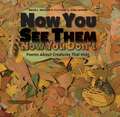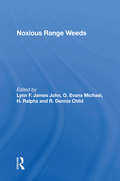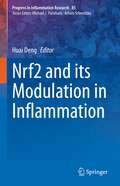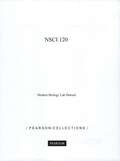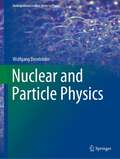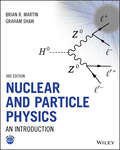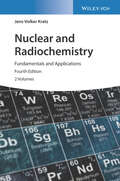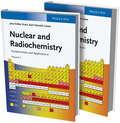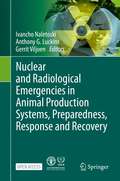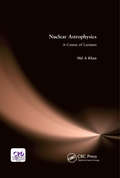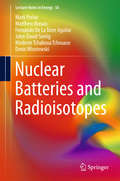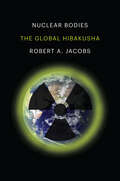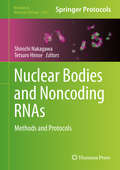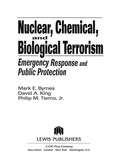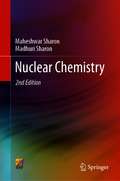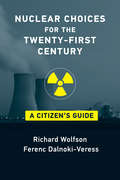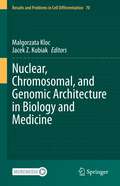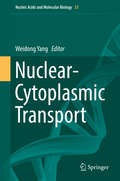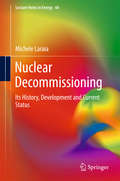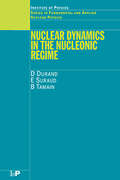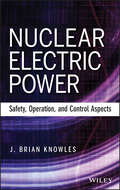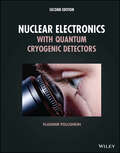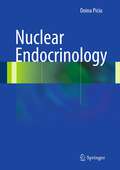- Table View
- List View
Now You See Them, Now You Don't: Poems About Creatures that Hide
by David L. HarrisonFind me if you can. . . for if you don&’t, I&’ll be here tomorrow . . . you won&’t. Animals and insects use camouflage to hide from hunters or to ambush prey. Stealth is a very useful technique when it comes to survival. In this fun and informative collection of poems, we meet animals such as the polar bear and the octopus; the ghost crab and the copperhead snake; and many more that use camouflage to hunt or to hide. Giles Laroche&’s intricate cut-paper illustrations are beautiful and life-like. Readers will have to look carefully or run the risk of a hunter sneaking up on them. Back matter offers additional information about each of the nineteen animals.
Nowhere Left to Go: How Climate Change Is Driving Species To The Ends Of The Earth
by Benjamin von BrackelHarrowing journeys of animals and plants—fleeing skyrocketing temperatures and mega-droughts—reported from the frontlines of the greatest migration of species since the Ice Age As humans accelerate global warming while laying waste to the environment, animals and plants must flee to the margins: on scattered nature reserves, between major highways, or among urban sprawl. And when even these places become too hot and inhospitable, wildlife is left with only one path to survival: an often-formidable journey toward the poles as they race to find a new home in a warming world. Tropical zones lose their inhabitants, beavers settle in Alaska, and gigantic shoals of fish disappear—just to reappear along foreign coastlines. Award-winning environmental journalist Benjamin von Brackel traces these awe-inspiring journeys and celebrates the remarkable resilience of species around the world. But the lengths these plants and animals must go to avoid extinction are as alarming as they are inspirational: Sea animals—like fish—move on average 45 miles a decade to cooler regions, while land animals—like beavers and butterflies—move 11 miles. As even the poles of the Earth heat up, we’re left with a stark and irreversible choice: Halt the climate emergency now, or face a massive die-off of species, who are increasingly left with nowhere else to go.
Noxious Range Weeds
by Lynn F JamesThis is a reference book on the classification, distribution, ecology and control of poisonous and aggressively invasive plant species on rangeland. The plants covered include leafy spurge, snakeweeds, thistles and knapweeds, woody species such as juniper, rabbitbrush, oakbrush, mesquite and saltcedar, and other noxious weeds such as dyers woad, cheatgrass and tansy ragwort.
Nrf2 and its Modulation in Inflammation (Progress in Inflammation Research #85)
by Huai DengNrf2, a transcription factor that mediates transcriptional responses to oxidative and xenobiotic stresses, plays a central role in cellular protection against internal or external toxins. Defects in Nrf2 and the relevant regulatory pathways are associated with a number of pathologies including inflammation, respiratory diseases, cardiovascular dysfunctions, metabolic syndrome and diabetes, neurodegeneration, and cancer. This book comprehensively reviews the up-to-date discoveries for the roles of Nrf2 in several human diseases in the context of inflammation. In particular, the molecular mechanisms that mediate the functions of Nrf2 and its interacting network in inflammation and pathogenesis are explicated. In addition, the research and therapeutic applications of Nrf2-targeting compounds in different diseases were summarized. This book is expected to be a valuable reference for worldwide researchers conducting both mechanistic and therapeutic studies of Nrf2 and relevant factors.
NSCI 120: Modern Biology Lab Manual
by DickeyScientific inquiry is a particular way of answering questions. It can’t be used for all types of questions. The questions that can be answered by science must meet specific guidelines and scientific investigations must be carried out using certain rules. When an investigation is designed properly and meets these guidelines, then the results are acceptable to other scientists and are added to the body of scientific knowledge. If an investigator cannot show that his or her experiment was done according to the guidelines, then the results of that experiment will not be recognized as valid by other scientists.
Nuclear and Particle Physics (Undergraduate Lecture Notes in Physics)
by Wolfgang DemtröderThis introduction to nuclear physics and particle physics provides an accessible and clear treatment of the fundamentals. Starting with the structure of nuclei and explaining instability of nuclei, this textbook enables the reader to understand all basics in nuclear physics. The text is written from the experimental physics point of view, giving numerous real-life examples and applications of nuclear forces in modern technology. This highly motivating presentation deepens the reader's knowledge in a very accessible way. The second part of the text gives a concise introduction to elementary particle physics, again together with applications and instrumentation. Nuclear fusion, fission, radionuclides in medicine and particle accelerators are amongst the many examples explained in detail. Numerous problems with solutions are perfect for self-study.
Nuclear and Particle Physics
by Brian MartinAn accessible introduction to nuclear and particle physics with equal coverage of both topics, this text covers all the standard topics in particle and nuclear physics thoroughly and provides a few extras, including chapters on experimental methods; applications of nuclear physics including fission, fusion and biomedical applications; and unsolved problems for the future. It includes basic concepts and theory combined with current and future applications. An excellent resource for physics and astronomy undergraduates in higher-level courses, this text also serves well as a general reference for graduate studies.
Nuclear and Particle Physics: An Introduction (Cambridge Monographs On Particle Physics, Nuclear Physics And Cosmology Ser. #25)
by Graham Shaw Brian R. MartinUpdated and expanded edition of this well-known Physics textbook provides an excellent Undergraduate introduction to the field This new edition of Nuclear and Particle Physics continues the standards established by its predecessors, offering a comprehensive and highly readable overview of both the theoretical and experimental areas of these fields. The updated and expanded text covers a very wide range of topics in particle and nuclear physics, with an emphasis on the phenomenological approach to understanding experimental data. It is one of the few publications currently available that gives equal treatment to both fields, while remaining accessible to undergraduates. Early chapters cover basic concepts of nuclear and particle physics, before describing their respective phenomenologies and experimental methods. Later chapters interpret data through models and theories, such as the standard model of particle physics, and the liquid drop and shell models of nuclear physics, and also discuss many applications of both fields. The concluding two chapters deal with practical applications and outstanding issues, including extensions to the standard model, implications for particle astrophysics, improvements in medical imaging, and prospects for power production. There are a number of useful appendices. Other notable features include: New or expanded coverage of developments in relevant fields, such as the discovery of the Higgs boson, recent results in neutrino physics, research to test theories beyond the standard model (such as supersymmetry), and important technical advances, such as Penning traps used for high-precision measurements of nuclear masses. Practice problems at the end of chapters (excluding the last chapter) with solutions to selected problems provided in an appendix, as well as an extensive list of references for further reading. Companion website with solutions (odd-numbered problems for students, all problems for instructors), PowerPoint lecture slides, and other resources. As with previous editions, the balanced coverage and additional resources provided, makes Nuclear and Particle Physics an excellent foundation for advanced undergraduate courses, or a valuable general reference text for early graduate studies.
Nuclear and Radiochemistry: Fundamentals and Applications
by Jens-Volker KratzThe leading resource for anyone looking for an accessible and authoritative introduction to nuclear and radiochemistry In the newly revised Fourth Edition of Nuclear and Radiochemistry: Fundamentals and Applications, distinguished chemist Jens-Volker Kratz delivers a two-volume handbook that has become the gold standard in teaching and learning nuclear and radiochemistry. The books cover the theory and fundamentals of the subject before moving on the technical side of nuclear chemistry, with coverage of nuclear energy, nuclear reactors, and radionuclides in the life sciences. This latest edition discusses the details and impact of the Chernobyl and Fukushima nuclear disasters, as well as new research facilities, including FAIR and HIM. It also incorporates new methods for target preparation and new processes for nuclear fuel recycling, like EURO-GANEX. Finally, the volumes extensively cover environmental technological advances and the effects of radioactivity on the environment. Readers will also find: - An accessible and thorough introduction to the fundamental concepts of nuclear physics and chemistry, including atomic processes, classical mechanics, relativistic mechanics, and the Heisenberg Uncertainty Principle - Comprehensive explorations of radioactivity in nature, radioelements, radioisotopes and their atomic masses, and other physical properties of nuclei - Practical discussions of the nuclear force, nuclear structure, decay modes, radioactive decay kinetics, and nuclear radiation - In-depth examinations of the statistical considerations relevant to radioactivity measurements Written for practicing nuclear chemists and atomic physicists, Nuclear and Radiochemistry: Fundamentals and Applications is also an indispensable resource for nuclear physicians, power engineers, and professionals working in the nuclear industry.
Nuclear and Radiochemistry
by Karl Heinrich Lieser Jens-Volker KratzThe third edition of this classic in the field is completely updated and revised with approximately 30% new content so as to include the latest developments.The handbook and ready reference comprehensively covers nuclear and radiochemistry in a well-structured and readily accessible manner, dealing with the theory and fundamentals in the first half, followed by chapters devoted to such specific topics as nuclear energy and reactors, radiotracers, and radionuclides in the life sciences. The result is a valuable resource for both newcomers as well as established scientists in the field.
Nuclear and Radiological Emergencies in Animal Production Systems, Preparedness, Response and Recovery
by Gerrit Viljoen Ivancho Naletoski Anthony G. LuckinsThis Open Access volume explains how major nuclear and radiological emergencies (NREs) can have implications at local, national and international level. The response to NREs requires a competent decision-making structure, clear communication and effective information exchange. National veterinary services have the responsibility to plan, design and manage animal production system in their countries. These activities cover animal health, animal movement control, production control and improvement, and control of the products of animal origin before their placement on the market. Release of radionuclides after NREs can cause substantial contamination in the animal production systems. Critical responsibility of veterinary authorities is therefore to prevent such contamination, establish early response mechanisms to mitigate the consequences and prevent placement of contaminated products of animal origin on the market for human consumption. This work summarizes the critical technical points for effective management of NREs for national veterinary services.
Nuclear Astrophysics: A Course of Lectures
by Md A. KhanIn this volume the physics involved in various astrophysical processes like the synthesis of light and heavier elements, explosive burning processes, core collapse supernova etc have been critically addressed with minimum mathematical derivations so as to suit all faculties of the readers. For graduate students there are solved problems with exercises at the end of each chapter, for researchers some recent works on the calculation of physical parameters of astrophysical importance like the calculation of Sfactors at low energies have been included, and for amateur readers there are lot of history, information and discussion on the astronuclear phenomenon.
Nuclear Batteries and Radioisotopes
by Mark Prelas Matthew Boraas Fernando De La Torre Aguilar John-David Seelig Modeste Tchakoua Tchouaso Denis WisniewskiThis book explains the physics of nuclear battery operation. It provides a comprehensive background that allows readers to understand all past and future developments in the field. The supply and cost of radioisotopes for use in applications (focused on nuclear batteries) are covered in the initial sections of the text. The interaction of ionizing radiation with matter is discussed as applied to nuclear batteries. The physics of interfacing the radioisotopes to the transducers which represent the energy conversion mechanism for nuclear batteries are described for possible nuclear battery configurations. Last but not least the efficiencies of nuclear battery configurations are discussed combined with a review of the literature on nuclear battery research.
Nuclear Bodies: The Global Hibakusha
by Robert A. JacobsThe Cold War reconsidered as a limited nuclear war &“Inexorable clarity and care for his fellow humans mark Robert Jacobs's guide to the Cold War as a limited nuclear war, whose harms disfigure any possible future.&”—Norma Field, author of In the Realm of a Dying Emperor: Japan at Century&’s End In the fall of 1961, President Kennedy somberly warned Americans about deadly radioactive fallout clouds extending hundreds of miles from H‑bomb detonations, yet he approved ninety‑six US nuclear weapon tests for 1962. Cold War nuclear testing, production, and disasters like Chernobyl and Fukushima have exposed millions to dangerous radioactive particles; these millions are the global hibakusha. Many communities continue to be plagued with dire legacies and ongoing risks: sickness and early mortality, forced displacement, uncertainty and anxiety, dislocation from ancestors and traditional lifestyles, and contamination of food sources and ecosystems. Robert A. Jacobs re‑envisions the history of the Cold War as a slow nuclear war, fought on remote battlegrounds against populations powerless to prevent the contamination of their lands and bodies. His comprehensive account necessitates a profound rethinking of the meaning, costs, and legacies of our embrace of nuclear weapons and technologies.
Nuclear Bodies and Noncoding RNAs
by Shinichi Nakagawa Tetsuro HiroseThis volume focuses on cytological, biochemical, and molecular biological methods to identify and examine the function of each nuclear body, with an emphasis on the analysis of long non-coding RNAs. Chapters focus on exploring recent studies that reveal how certain long non protein-coding RNAs accumulate in specific nuclear bodies and regulate the function of the bodies by serving as architectural components or controlling the dynamics of associating protein components. Written in the highly successful Methods of Molecular Biology series format, chapters include introductions to their respective topics, lists of the necessary materials and reagents, step-by-step, readily reproducible laboratory protocols, and key tips on troubleshooting and avoiding known pitfalls. Authoritative and practical, Nuclear Bodies and Noncoding RNAs: Methods and Protocols serves as a guideline for further study into the sophisticated regulation of gene expression.
Nuclear, Chemical, and Biological Terrorism: Emergency Response and Public Protection
by Mark E. Byrnes David A. King Philip M. Tierno Jr.This book provides guidance on measures that should be considered to protect human lives from terrorist activities involving nuclear, chemical, and biological weapons. It provides a historical summary of the development and use of these weapons, and continues with a detailed discussion of the types of radiation and warfare agents that are available
Nuclear Chemistry: Detection And Analysis Of Radiation
by Maheshwar Sharon Madhuri SharonThis book is designed to serve as a textbook for core courses offered to postgraduate students enrolled in chemistry. This book can also be used as a core or supplementary text for nuclear chemistry courses offered to students of chemical engineering. The book covers various topics of nuclear chemistry like Shell model, fission/fusion reaction, natural radioactive equilibrium series, nuclear reactions carried by various types of accelerators. In addition, it describes the law of decay of radioactivity, type of decay, and interaction of radiation with matter. It explains the difference between ionization counter, scintillation counter and solid state detector. This book also consists of end-of-book problems to help readers aid self-learning. The detailed coverage and pedagogical tools make this an ideal textbook for postgraduate students and researchers enrolled in various chemistry and engineering courses. This book will also be beneficial for industry professionals in the allied fields.
Nuclear Choices for the Twenty-First Century: A Citizen's Guide
by Richard Wolfson Ferenc Dalnoki-VeressAn authoritative and unbiased guide to nuclear technology and the controversies that surround it.Are you for nuclear power or against it? What's the basis of your opinion? Did you know a CT scan gives you some 2 millisieverts of radiation? Do you know how much a millisievert is? Does irradiation make foods safer or less safe? What is the point of a bilateral Russia-US nuclear weapons treaty in a multipolar world? These are nuclear questions that call for nuclear choices, and this book equips citizens to make these choices informed ones. It explains, clearly and accessibly, the basics of nuclear technology and describes the controversies surrounding its use.
Nuclear, Chromosomal, and Genomic Architecture in Biology and Medicine (Results and Problems in Cell Differentiation #70)
by Malgorzata Kloc Jacek Z. KubiakThis volume reviews the latest research on the functional implications of nuclear, chromosomal and genomic organization and architecture on cell and organismal biology, and development and progression of diseases.The architecture of the cell nucleus and non-random arrangement of chromosomes, genes, and the non-membranous nuclear bodies in the three-dimensional (3D) space alters in response to the environmental, mechanical, chemical, and temporal cues. The changes in the nuclear, chromosomal, or genomic compaction and configuration modify the gene expression program and induce or inhibit epigenetic modifications. The intrinsically programmed rearrangements of the nuclear architecture are necessary for cell differentiation, the establishment of cell fate during development and maturation of tissues and organs including the immune, muscle, and nervous systems.The non-programmed changes in the nuclear architecture can lead to fragmentation of the nucleus and instability of the genome and thus cause cancer. Microbial and viral infections can lead to a clustering of centromeres, telomeres and ribosomal DNA and alter the properties of the nuclear membrane, allowing large immobile macromolecules to enter the nucleus. Recent advances in next-generation sequencing technologies combined with nucleus/chromosome conformation capture, super-resolution imaging, chromosomal contact maps methods, integrative modeling, and genetic approaches, are uncovering novel features and importance of nuclear, chromosomal and genomic architecture. This book is an interesting read for cell biologists, researchers studying the structure and function of chromosomes, and anyone else who wants to get an overview of the field of nuclear, chromosomal and genomic architecture.
Nuclear-Cytoplasmic Transport (Nucleic Acids And Molecular Biology Ser. #33)
by Weidong YangDysfunction of nuclear-cytoplasmic transport systems has been associated with many human diseases. Thus, understanding of how functional this transport system maintains, or through dysfunction fails to maintain remains the core question in cell biology. In eukaryotic cells, the nuclear envelope (NE) separates the genetic transcription in the nucleus from the translational machinery in the cytoplasm. Thousands of nuclear pore complexes (NPCs) embedded on the NE selectively mediate the bidirectional trafficking of macromolecules such as RNAs and proteins between these two cellular compartments. In this book, the authors integrate recent progress on the structure of NPC and the mechanism of nuclear-cytoplasmic transport system in vitro and in vivo.
Nuclear Decommissioning: Planning, Execution And International Experience (Woodhead Publishing Series In Energy Ser.)
by Michele LaraiaThis book discusses the history of nuclear decommissioning as a science and industry. It explores the early, little-known period when the term “decommissioning” was not used in the nuclear context and the end-of-life operations of a nuclear facility were a low priority. It then describes the subsequent period when decommissioning was recognized as a separate phase of the nuclear lifecycle, before bringing readers up to date with today’s state of the art.The author addresses decommissioning as a mature industry in an era in which large, commercial nuclear reactors and other fuel-cycle installations have been fully dismantled, and their sites returned to other uses. The book also looks at the birth, growth and maturity of decommissioning, focusing on how new issues emerged, how these were gradually addressed, and the lessons learned from them. Further, it examines the technologies and management advances in science and industry that followed these solutions. Nuclear Decommissioning is a point of reference for industry researchers and decommissioning practitioners looking to enrich their knowledge of decommissioning in recent decades as well as the modern industry. The book is also of interest to historians and students who wish to learn more about the history of nuclear decommissioning.
Nuclear Dynamics in the Nucleonic Regime (Series in Fundamental and Applied Nuclear Physics)
by D Durand E Suraud B TamainOver the last decade one of the most active areas of research in nuclear physics has been the study of systems of nucleons in various dynamical situations. Heavy-ion collisions at beam energies in the range 30-150 MeV per nucleon, where subnucleaonic degrees of freedom can be considered as frozen, allow such systems to be studied in detail. Nuclear
Nuclear Electric Power
by J. Brian KnowlesAssesses the engineering of renewable sources for commercial power generation and discusses the safety, operation, and control aspects of nuclear electric powerFrom an expert who advised the European Commission and UK government in the aftermath of Three Mile Island and Chernobyl comes a book that contains experienced engineering assessments of the options for replacing the existing, aged, fossil-fired power stations with renewable, gas-fired, or nuclear plants.From geothermal, solar, and wind to tidal and hydro generation, Nuclear Electric Power: Safety, Operation, and Control Aspects assesses the engineering of renewable sources for commercial power generation and discusses the important aspects of the design, operation, and safety of nuclear stations.Nuclear Electric Power offers:Novel, practical engineering assessments for geothermal, hydro, solar, tidal, and wind generation in terms of the available data on cost, safety, environmental damage, capacity factor reliability, and grid compatibility, with some nuclear comparisonsEigenvalues and real frequency response functions to assess the stabilities of reactor power, two-phase channel flow, and a Grid networkA non-linear control strategy with simulation results for a Design Base Accident scenarioOriginal analyses with experimental validation of molten fuel coolant interactions and aircraft impacts on rigid structuresAnalysis of the circumstances that led to the Fukushima disasterNuclear Electric Power is an important book for all international nuclear power agencies and those who work within the field.
Nuclear Electronics with Quantum Cryogenic Detectors
by Vladimir PolushkinNUCLEAR ELECTRONICS WITH QUANTUM CRYOGENIC DETECTORS An ideal, comprehensive reference on quantum cryogenic detector instrumentation for the semiconductor and nuclear electronics industries Quantum nuclear electronics is an important scientific and technological field that overviews the development of the most advanced analytical instrumentation. This instrumentation covers a broad range of applications such as astrophysics, fundamental nuclear research facilities, chemical nano-spectroscopy laboratories, remote sensing, security systems, forensic investigations, and more. In the years since the first edition of this popular resource, the discipline has developed from demonstrating the unprecedented energy resolving power of individual devices to building large frame cameras with hundreds of thousands of pixel arrays capable of measuring and processing massive information flow. Building upon its first edition, the second edition of Nuclear Electronics with Quantum Cryogenic Detectors reflects the latest advances by focusing on novel microwave kinetic inductance detection devices (MKIDs), the microwave superconducting quantum interferometers (MSQUIDs) extending by orders of magnitude the scalability of cryogenic detectors implementing newly developed multiplexing techniques and decoding algorithms. More, it reflects on the interaction of quantum cryogenic detectors—which in turn can be paired with semiconductor large frame cameras to provide a broad picture of a sky or chemical sample—and quantum devices, making this second edition of Nuclear Electronics a one-stop reference for the combined technologies. The book also provides an overview of latest developments in front-end electronics, signal processing channels, and cryogenics—all components of quantum spectroscopic systems—and provides guidance on the design and applications of the future quantum cryogenic ultra-high-resolution spectrometers. Nuclear Electronics with Quantum Cryogenic Detectors readers will also find: Fully revised material from the first edition relating to cryogenic requirements Brand new chapters on semiconductor radiation sensors, cooling and magnetic shielding for cryogenic detector systems; front-end readout electronic circuits for quantum cryogenic detectors; energy resolution of quantum cryogenic spectrometers; and applications of spectrometers based on cryogenic detectors A number of brand-new chapters dedicated to applications using MSQUID multiplexing technique, an area that will dominate the cryogenic detector field in the next decades Nuclear Electronics with Quantum Cryogenic Detectors provides a comprehensive overview of the entire discipline for researchers, industrial engineers, and graduate students involved in the development of high-precision nuclear measurements, nuclear analytical instrumentation, and advanced superconductor primary sensors. It is also a helpful resource for electrical and electronic engineers and physicists in the nuclear industry, as well as specialist researchers or professionals working in cryogenics applications like biomagnetism, quantum computing, gravitation measurement, and more.
Nuclear Endocrinology
by Doina PiciuNuclear medicine is an important element of daily practice for the endocrinologist, both for diagnosis and for treatment. The continuous rapid development of nuclear medicine procedures has created the need for a concise, up-to-date practical guide that presents the essential information required by the endocrinologist. This book is designed to ensure ease of use in clinical practice and provides the most relevant information on nuclear medicine as applied to endocrine pathology. It is divided into three sections covering general aspects of nuclear medicine, the role of nuclear endocrinology in diagnosis, and the role of nuclear endocrinology in therapy. The endocrine glands are covered by organ and by pathology. Pertinent background information is provided, choice of radiopharmaceutical is explained, and the role of different image acquisition techniques is discussed. In addition, informative clinical cases are presented with the aid of high-quality images.
